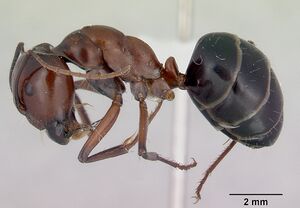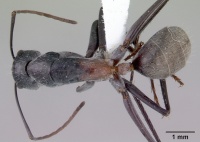Camponotus prosseri
| Camponotus prosseri | |
|---|---|

| |
| Scientific classification | |
| Kingdom: | Animalia |
| Phylum: | Arthropoda |
| Class: | Insecta |
| Order: | Hymenoptera |
| Family: | Formicidae |
| Subfamily: | Formicinae |
| Tribe: | Camponotini |
| Genus: | Camponotus |
| Species: | C. prosseri |
| Binomial name | |
| Camponotus prosseri Shattuck & McArthur, 2002 | |
These ants have been found in mallee, Callitris woodlands and coastal scrub. They are known to nest under stones as well as in open soil without covering, especially in sand, and they have been taken in pitfall traps. They are known to forage on low vegetation including malice and yellow box.
Identification
Anterior clypeal margin in major workers broadly convex across its entire width. Scapes relatively long (in minor workers, SI > 1.4). Tibiae lacking erect hairs, propodeum with more than 10 erect hairs which are scattered along the entire dorsal surface. Posterior section of mesonotum weakly but distinctly convex immediately anterior of the metanotal groove (more so in minors, less so in majors); metanotal groove a shallow, weakly defined concavity in minors. Petiolar node angular or broadly rounded above, the anterior face at most only slightly shorter than the posterior face. Head same colour as mesonotum (both either red or black).
This species is morphologically similar to Camponotus ceriseipes and is easily confused with it. The surest way to separate these species is based on scape length. In larger minor workers of C. prosseri the scape is relatively long compared with similar sized C. ceriseipes workers. Note, however, that this difference is minimal or non-existent in smaller workers due to allometry in this character. Other characters useful in separating minor workers of these taxa are the generally lower and broader node and duller integument in C. prosseri compared to the higher and narrower petiolar node and shiny integument in C. ceriseipes. The shape of the node works well for the majority of minor workers while the shininess of the integument is more problematic due to the highly qualitative nature of, and greater variation in, this character.
Keys including this Species
- Key to Australian Camponotus majors of the southwestern Botanical Province
- Key to Australian Camponotus minors of the southwestern Botanical Province
- Key to Australian Camponotus species
Distribution
Latitudinal Distribution Pattern
Latitudinal Range: -24.96535° to -35.68333435°.
| North Temperate |
North Subtropical |
Tropical | South Subtropical |
South Temperate |
- Source: AntMaps
Distribution based on Regional Taxon Lists
Australasian Region: Australia (type locality).
Distribution based on AntMaps
Distribution based on AntWeb specimens
Check data from AntWeb
Countries Occupied
| Number of countries occupied by this species based on AntWiki Regional Taxon Lists. In general, fewer countries occupied indicates a narrower range, while more countries indicates a more widespread species. |

|
Estimated Abundance
| Relative abundance based on number of AntMaps records per species (this species within the purple bar). Fewer records (to the left) indicates a less abundant/encountered species while more records (to the right) indicates more abundant/encountered species. |

|
Biology
Castes
Worker
Major
Images from AntWeb
   
| |
| Paratype of Camponotus prosseri. Worker. Specimen code casent0172147. Photographer April Nobile, uploaded by California Academy of Sciences. | Owned by ANIC, Canberra, Australia. |
Nomenclature
The following information is derived from Barry Bolton's Online Catalogue of the Ants of the World.
- prosseri. Camponotus prosseri Shattuck & McArthur, 2002: 78, figs. 15, 33-37 (s.w.q.m.) AUSTRALIA (South Australia).
- Type-material: holotype minor worker, 25 paratype major and minor workers, 10 paratype queens, 1 paratype male.
- Type-locality: holotype Australia: South Australia, Streaky Bay, 30.viii.1974 (B.B. Lowery); paratypes with same data.
- Type-depositories: ANIC (holotype); ANIC, SAMA (paratypes).
- Status as species: McArthur, 2007a: 314; Heterick, 2009: 62; McArthur, 2010: 56; McArthur, 2014: 112.
- Distribution: Australia.
Type Material
- Holotype, minor worker, Streaky Bay, South Australia, Australia, 30 August 1974, B.B. Lowery, Australian National Insect Collection; mallee, in sand.
- Paratype, 23 workers, 10 queens, Streaky Bay, South Australia, Australia, 30 August 1974, B.B. Lowery, Australian National Insect Collection; mallee, in sand.
- Paratype, 2 workers, 1 male, Streaky Bay, South Australia, Australia, 30 August 1974, B.B. Lowery, South Australian Museum; mallee, in sand.
The specimens considered by Shattuck & McArthur (2002) as belonging to this species show consistency in overall head, mesosomal and petiolar shape as well as overall size. The length of the scape varies but this variation is highly correlated with head width as would be expected for a single taxon. However, these specimens do show considerable variation in colour and to a lesser extent pilosity. Allowing for a few apparently callow or faded individuals, all specimens have the head and gaster black. The mesosoma, petiole and legs, however, vary from black to yellowred. These colours show considerable variation in intensity with essentially all shades between the extremes present. In general most nest series are fairly consistent in colour pattern with the exception of the petiole and legs, which can vary among individuals. However, the variation between series shows a more interesting pattern. The pronotum is generally black but is partially to completely red in a few collections from Western Australia. The mesosoma and propodeum vary from black to red but this variation occurs throughout the range of the species and the lighter colour is much more common, especially for the propodeum where red is more common than black. It should be noted that the development of the red colour follows a distinct pattern. The propodeum must be red for the mesonotum to be red, and the mesonotum must be red for the pronotum to be red. This means that the most common colour pattern is black with a red propodeum followed by black pronotum with red mesonotum and propodeum and finally individuals with a completely red mesosoma. The colours of the petiole and legs vary independently of the mesosoma.
The variation in pilosity is substantial but generally less obvious than that found in body colour. Both the erect hairs and appressed pubescence vary from sparse to abundant on all major body regions. And as with colour, most variation occurs between nest series rather than within nest series. However, no significant geographic pattern was detected regarding the development of pilosity, and there was no obvious correlation between colour patterns and pilosity. The only exception to this is a set of specimens from south-western Western Australia which had abundant long erect setae. In spite of this one group, it proved difficult to segregate the available material into subsets for which diagnoses could be developed. There were distinct sets of individuals which shared colour or pilosity patterns but there remained a number of specimens which were either intermediate between these sets or which could not be placed comfortably within these sets. As a result, all of these specimens are here treated as belonging to a single, wide-ranging taxon which shows considerable variation in a number of characters, with a note that some of these may well represent distinct species which are not diagnosable with the material currently available.
Description
Major worker
Anterior clypeal margin weakly convex, scarcely projecting, with a weak carina. Pronotum and mesonotum gently convex, metanotum distinct, dorsal propodeal face weakly convex, sometimes a little stronger near metanotum; angle well rounded. Anterior face of petiolar node straight, summit rounded, posterior face straight, often feebly concave near summit in dorsal view. Posterior margin and underside of head, mesosoma, petiole and gaster with scattered long setae, tibiae and stapes lacking erect setae. Head red to black, scape red to black, funiculus dark brown; pronotum red to dark brown; mesonotum red to dark brown; petiole red to black; gaster very dark brown to black; legs red to black.
Minor worker
Anterior clypeal margin convex, canna distinct. Pronotum and mesonotum an even, wide convexity, metanotum indistinct, propodeal dorsum feebly concave anteriorly, straight posteriorly, angle widely rounded, ratio of dorsum to declivity near 2. Anterior face of petiolar node short, flat, inclined forward, summit rounded, about as high as long, posterior face short, flat. Posterior margin and underside of head, mesosoma, petiole and gaster with scattered long setae, tibiae and stapes lacking erect hairs. Head and mesosoma clothed in fine flat-lying pubescence sufficiently dense in places to hide the integument. Head red to black, scape red to black, funiculus dark brown; pronotum, mesonotum, propodeum and petiole each red to black; gaster very dark brown to black; legs red to black.
Measurements
Workers (n=94). CI 0.72 (minor) — 1.21 (major); HL 1.50mm — 3.21mm; HW 1.08mm — 3.88mm; ML 2.41mm — 4.13mm; MTL 2.14mm — 2.66mm; PnW 0.98mm — 2.42mm; SI 0.70 (major) — 1.76 (minor); SL 1.90mm — 2.71 mm.
Etymology
Named after Dr Ian Prosser, Canberra, Australia.
References
- Heterick, B.E. 2021. A guide to the ants of Western Australia. Part I: Systematics. Records of the Western Australian Museum, Supplement 86, 1-245 (doi:10.18195/issn.0313-122x.86.2021.001-245).
- Heterick, B.E. 2022. A guide to the ants of Western Australia. Part II: Distribution and biology. Records of the Western Australian Museum, supplement 86: 247-510 (doi:10.18195/issn.0313-122x.86.2022.247-510).
- Shattuck, S.O. and McArthur, A.J. 2002. A taxonomic revision of the Camponotus wiederkehri and perjurus species-groups (Hymenoptera: Formicidae). Transactions of the Royal Society of South Australia. 126:63-90. (page 32, Figs. 15, 33-37 major, minor described)
References based on Global Ant Biodiversity Informatics
- Gunawardene N. R. and J. D. Majer. 2005. The effect of fire on ant assemblages in the Gibson Desert Nature Reserve, Western Australia. Journal of Arid Environments 63: 725-739.
- Heterick B. E. 2009. A guide to the ants of south-western Australia. Records of the Western Australian Museum Supplement 76: 1-206.
- Shattuck S. O., A . J. McArthur. 2002. A taxonomic revision of the Camponotus wiederkehri and perjurus species-groups (Hymenoptera: Formicidae). Transactions of the Royal Society of South Australia 126: 63-90.

